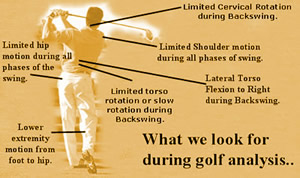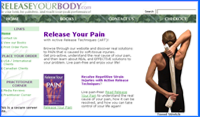|
How can ART improve my golfing?

Golf Analysis - We Can Help...
Your golf swing is all about proper body mechanics. A good golf swing requires full rotational capacity of nearly every joint involved and must be done - efficiently - easily - explosively - repeatedly. Many swing faults are directly attributable to poor joint mobility, resulting from soft-tissue restrictions.
At Kinetic Health we provide you with a means to enhance your Golf performance by identifying and releasing restrictions that reduce performance and cause injuries.
During this analysis we:
- Determine which structures are affected along the Golfers kinetic chain. We focus on more than just the chief area of restriction.
- Identify the antagonistic structures (opposing muscle groups) to those that have been identified as the primary structures causing the imbalance.
- Since function and performance is based upon balance and coordination, an opposing soft-tissue structure is always affected by restrictions in the primary structure.
- Then treat each soft-tissue dysfunction with the appropriate technique to restore full function to the affected structures.
- The result is almost most always an improvement in Golf performance. Using this process have helped hundreds of Golfers achieve their goals and prevent numerous injuries from occurring.
|
Common Swing Faults
Why do my muscles feel tight
Stretching will not break adhesions!
Applying ART to Golf Related Injuries
Read Articles About Golf Swing Analysis and ART
Make an Appointment
Read Dr. Abelson Blog on Injury and Performance Care

|
| Common Swing Faults |
 |
Common swing faults occur due to :
Common swing faults can be identified in the following areas:
|
When shoulder rotation is restricted
the body compensates with excessive spinal rotation. This can result
in back injury because most people
already lack flexibility in the spine.
In addition, golfers will notice
that they have difficulties in:
- Keeping their eyes on the ball.
- Maintaining an optimal swing plane.
This results in fat or thin shots. When the golfer
attempts to compensate at the shoulder joint, the chances of a hook
or slice increases. |
| Tightness in the hip
joint rotational muscles places additional strain on the rotational
requirements of the shoulder or spine. Often a golfer will compensate
by lifting up during the back swing and then chop down on the ball
resulting in a fat shot. |
| Wrist and elbow injuries often occurs
when the body does not have the capacity to effectively compensate
at either the shoulder or spine. The wrists are then over-used to
drive as well as decelerate the golf club. |
| Why do my muscles feel tight?
|
 |
Muscles become shortened due to injury, from trauma, or
from repetitive strains that cause micro-tears.
The scar tissue which forms at the injury site is less elastic
and more fibrotic than normal tissue, and causes muscles to gradually
loose their stretch component. Short tight muscles are weaker, more prone
to injury, and play havoc with your golf swing.
Usually more than one muscle is involved. The body lays
down fibrous adhesions between these muscle layers which restricts the
muscles ability to slide freely past one another, disrupts joint mechanics,
and cause the muscles to feel tight.
Shortened muscles and tightened joints, all combine to impair
coordination, reduce power, and result in further injuries. This cycle
will repeat itself unless these restriction are released.
| Stretching Will Not Break
The Adhesions! |
 |
Even individuals such as professional athletes who are constantly
stretching find it difficult to release these soft tissue adhesions.
This is why so many professional and amateur athletes are
turning to Active Release Technique (ART)
to release and remove these restrictions. Scar tissue (or soft tissue
adhesions) is several times stronger that normal tissue. Often muscle
groups will literally adhere to each other, preventing the sliding necessary
for full mobility.
During normal stretching, the first tissue that elongates
is not the scar tissue, but the normal healthy tissue. Stretching is essential
at the right time, but it never releases the restrictions that often occur
between two soft tissue surfaces.
| Applying ART
to Golf Related Injuries |
 |
In order to effectively balance your muscles and remove
joint restrictions we must first identify your unique pattern of muscle
imbalances.
By utilizing a series of muscle balance and swing analysis
tests, we can identify the exact type, extent, and location of muscle
restriction. We then use ART treatments and follow-up stretches to remove
and resolve these restrictions, and then strengthen the muscles to prevent
re-injury.
Applying ART
Once the shortened muscles are identified, ART treatment
works to break up the adhesion/scar tissue and return integrity back to
the soft tissue. This is done by :
- Maintaining a contact on the adhesion, with the muscle
in a shortened position.
- Elongating the muscle along its fiber orientation to
break up the adhesion.
Once the adhesion is broken up, the soft tissue can glide
unimpeded, allowing you to reach the positions your golf professionals
are showing you without tension, pain, or further injury.
See the following topics for more information about ART:
Where can I find more information
about ART?
We have recently published the first book about Active Release
Techniques, written specifically for the general public.
|
Release Your Pain - Resolving Repetitive
Strain Injuries with Active Release Techniques® (ART®)
is an informative, easy-to-read book, that helps you to understand
the true cause of repetitive strain injuries.
Did you know that many common therapies
(such as medication, physiotherapy, chiropractic treatment, massage,
electrical muscle stimulation, rest, exercise, and surgery) have
all failed to effectively resolve repetitive strain injuries. RSI
sufferers are rarely able to find effective or complete treatment
with these traditional treatments! Read Release
Your Pain now to understand why these treatments often fail
to solve your problem.
|
Understand the true cause of your pain, learn
how it can be resolved, then use the specially designed exercises included
in this book to prevent its reoccurrence.
Read our new book, Release
Your Pain, to see how Active Release Techniques can help you with
your injuries.
| Read
Articles about Golf Swing Analysis
|
 |
| Read this article.... |
For information about... |
| Improve
Your Golf Swing with Active Release Technique |
How you can increase performance in
Golf by ensuring proper body mechanics are in effect. ART can remove
the adhesions that restrict body motions, and provide up to 20% increase
in your golf swing.
|
| Golfers
Elbow |
A recurrent problem suffered
by Golfers, and how just 3 to 4 ART treatments can resolve this condition. |
| Improve
Your Athletic Performance with Active Release Technique |
How ART was used to at the Ironman
Triathlon Championships in Penticton and Kona, Hawaii to help resolve
athletic injuries, improve performance, and assist athletes in completing
these tremendously difficult events.
|


Click the image for information about Dr. Abelson's publications.
|



